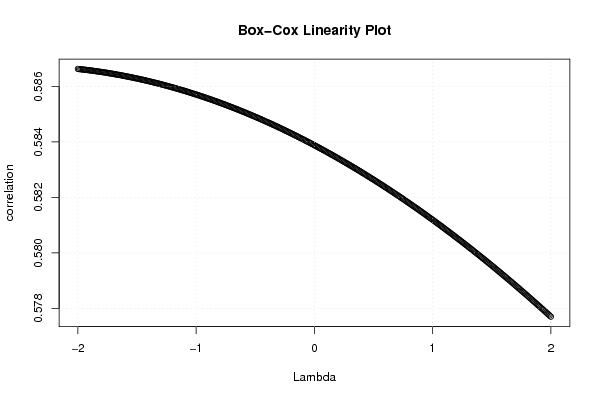Free Statistics
of Irreproducible Research!
Description of Statistical Computation | |||||||||||||||||||||||||||||||||||||||||||||
|---|---|---|---|---|---|---|---|---|---|---|---|---|---|---|---|---|---|---|---|---|---|---|---|---|---|---|---|---|---|---|---|---|---|---|---|---|---|---|---|---|---|---|---|---|---|
| Author's title | |||||||||||||||||||||||||||||||||||||||||||||
| Author | *The author of this computation has been verified* | ||||||||||||||||||||||||||||||||||||||||||||
| R Software Module | rwasp_boxcoxlin.wasp | ||||||||||||||||||||||||||||||||||||||||||||
| Title produced by software | Box-Cox Linearity Plot | ||||||||||||||||||||||||||||||||||||||||||||
| Date of computation | Tue, 11 Nov 2008 08:33:03 -0700 | ||||||||||||||||||||||||||||||||||||||||||||
| Cite this page as follows | Statistical Computations at FreeStatistics.org, Office for Research Development and Education, URL https://freestatistics.org/blog/index.php?v=date/2008/Nov/11/t1226417608yx8zd97xl755ily.htm/, Retrieved Sun, 19 May 2024 12:04:26 +0000 | ||||||||||||||||||||||||||||||||||||||||||||
| Statistical Computations at FreeStatistics.org, Office for Research Development and Education, URL https://freestatistics.org/blog/index.php?pk=23602, Retrieved Sun, 19 May 2024 12:04:26 +0000 | |||||||||||||||||||||||||||||||||||||||||||||
| QR Codes: | |||||||||||||||||||||||||||||||||||||||||||||
|
| |||||||||||||||||||||||||||||||||||||||||||||
| Original text written by user: | |||||||||||||||||||||||||||||||||||||||||||||
| IsPrivate? | No (this computation is public) | ||||||||||||||||||||||||||||||||||||||||||||
| User-defined keywords | |||||||||||||||||||||||||||||||||||||||||||||
| Estimated Impact | 134 | ||||||||||||||||||||||||||||||||||||||||||||
Tree of Dependent Computations | |||||||||||||||||||||||||||||||||||||||||||||
| Family? (F = Feedback message, R = changed R code, M = changed R Module, P = changed Parameters, D = changed Data) | |||||||||||||||||||||||||||||||||||||||||||||
| F [Bivariate Kernel Density Estimation] [] [2008-11-11 15:01:49] [29747f79f5beb5b2516e1271770ecb47] F RMPD [Partial Correlation] [] [2008-11-11 15:17:50] [29747f79f5beb5b2516e1271770ecb47] F RMPD [Trivariate Scatterplots] [] [2008-11-11 15:21:20] [29747f79f5beb5b2516e1271770ecb47] F RMPD [Box-Cox Linearity Plot] [] [2008-11-11 15:33:03] [c0a347e3519123f7eef62b705326dad9] [Current] | |||||||||||||||||||||||||||||||||||||||||||||
| Feedback Forum | |||||||||||||||||||||||||||||||||||||||||||||
Post a new message | |||||||||||||||||||||||||||||||||||||||||||||
Dataset | |||||||||||||||||||||||||||||||||||||||||||||
| Dataseries X: | |||||||||||||||||||||||||||||||||||||||||||||
97.6 96.9 105.6 102.8 101.7 104.2 92.7 91.9 106.5 112.3 102.8 96.5 101.0 98.9 105.1 103.0 99.0 104.3 94.6 90.4 108.9 111.4 100.8 102.5 98.2 98.7 113.3 104.6 99.3 111.8 97.3 97.7 115.6 111.9 107.0 107.1 100.6 99.2 108.4 103.0 99.8 115.0 90.8 95.9 114.4 108.2 112.6 109.1 105.0 105.0 118.5 103.7 112.5 116.6 96.6 101.9 116.5 119.3 115.4 108.5 111.5 108.8 121.8 109.6 112.2 119.6 104.1 105.3 115.0 124.1 116.8 107.5 115.6 116.2 116.3 119.0 111.9 118.6 106.7 | |||||||||||||||||||||||||||||||||||||||||||||
| Dataseries Y: | |||||||||||||||||||||||||||||||||||||||||||||
89,6 92,8 107,6 104,6 103,0 106,9 56,3 93,4 109,1 113,8 97,4 72,5 82,7 88,9 105,9 100,8 94,0 105,0 58,5 87,6 113,1 112,5 89,6 74,5 82,7 90,1 109,4 96,0 89,2 109,1 49,1 92,9 107,7 103,5 91,1 79,8 71,9 82,9 90,1 100,7 90,7 108,8 44,1 93,6 107,4 96,5 93,6 76,5 76,7 84,0 103,3 88,5 99,0 105,9 44,7 94,0 107,1 104,8 102,5 77,7 85,2 91,3 106,5 92,4 97,5 107,0 51,1 98,6 102,2 114,3 99,4 72,5 92,3 99,4 85,9 109,4 97,6 104,7 56,5 | |||||||||||||||||||||||||||||||||||||||||||||
Tables (Output of Computation) | |||||||||||||||||||||||||||||||||||||||||||||
| |||||||||||||||||||||||||||||||||||||||||||||
Figures (Output of Computation) | |||||||||||||||||||||||||||||||||||||||||||||
Input Parameters & R Code | |||||||||||||||||||||||||||||||||||||||||||||
| Parameters (Session): | |||||||||||||||||||||||||||||||||||||||||||||
| Parameters (R input): | |||||||||||||||||||||||||||||||||||||||||||||
| R code (references can be found in the software module): | |||||||||||||||||||||||||||||||||||||||||||||
n <- length(x) | |||||||||||||||||||||||||||||||||||||||||||||

















